Corsair Hydro H60 (2018) AIO Liquid CPU Cooler Review
Pros
Cons
Rating
Introduction
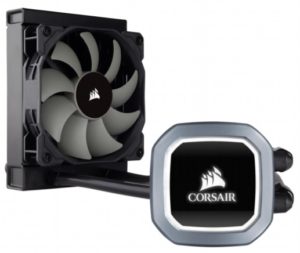 Welcome to yet another CPU cooler review! Back in 2017, we conducted three massive cooler shootouts (120mm air on Intel, 120mm air on AMD, and 240mm-280mm liquid on AMD), which provided us a great baseline to conduct one-off reviews going forward. Truth be told, cooler shootouts are incredibly time-intensive, so we’re probably not going to be doing many more of them. Instead we’re going to be picking out new coolers that hit the market at great pricepoints, with great new features, or ideally both!
Welcome to yet another CPU cooler review! Back in 2017, we conducted three massive cooler shootouts (120mm air on Intel, 120mm air on AMD, and 240mm-280mm liquid on AMD), which provided us a great baseline to conduct one-off reviews going forward. Truth be told, cooler shootouts are incredibly time-intensive, so we’re probably not going to be doing many more of them. Instead we’re going to be picking out new coolers that hit the market at great pricepoints, with great new features, or ideally both!
And that brings us to the subject of today’s review, the Corsair Hydro H60. Now, we know what you’re thinking. If you’ve been in the PC mod community for while, you’ll say “wasn’t this released in 2011, and didn’t you just say TBG is just reviewing new coolers?” Well, yes, and yes! You see, Corsair has decided that it will be sticking with model names that prove popular with users, and believe it or not, this is the third H60 cooler to be released since 2011, by our count (we may have missed some!). The way to know what you’re actually getting is by looking at the model number, not the name – the model we’re reviewing here is CW-9060036-WW, and it was released on March 22, 2018 (for those keeping track!). The 2011 original was CWCH60, and the 2013 release was CW-9060007-WW. This new model brings a whole bunch of improvements to the table, from a sleeker design, to LED lighting, to a much quieter fan. It’s also the first sub $140 cooler from Corsair to include AMD AM4 brackets for Ryzen processors right in the box. And that’s critical for this review, as we’re going to be using our Ryzen 7 1700 system as our cooler testbed for the foreseeable future.
Special thanks to Corsair for providing a review sample of the Hydro H60 CW-9060036-WW (2018).
The Test
So, as we were saying, we use a Ryzen platform to test our coolers. Here are the specs of the system as configured:
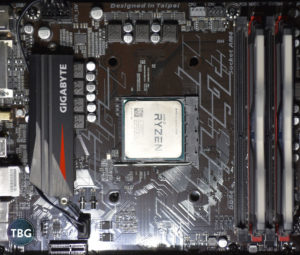
- CPU: AMD Ryzen 7 1700 (thank you to AMD for providing this review sample)
- Motherboard: Gigabyte GA-AB350-Gaming 3
- Video Card: Sapphire Radeon R9 Fury Nitro+ 4GB
- SSD #1: Samsung 960 Evo 500GB M.2
- SSD #2: Crucial MX300 525GB 2.5″
- RAM: GeIL 2x8GB Super Luce DDR4-3000
- Case: Thermaltake View 31 RGB (thank you to Thermaltake for providing this review sample)
- Power Supply: Corsair HX750 Platinum (thank you to Corsair and Newegg for providing this review sample)
- Operating System: Windows 10 Flash Drive
This being our AMD platform, we felt we had to include an AMD-based video card, but AMD’s new Vega series is a complete bust in our opinion, so we turned to our trusty Sapphire Radeon Fury Nitro. No, you shouldn’t buy it today (and in fact, you can’t because it’s been discontinued), but it’s still a potent gaming weapon, easily beating out anything you can find for under $350 today (we picked ours up for $250 a year ago, which is a sign of how the mid-priced market has suffered in the age of cryptocurrency mining). The other great thing about the Fury Nitro is that it has a zero-fan mode, which was critical to our noise testing. During all of our CPU cooler testing, it remained completely silent.
We should also call out our case of choice, the Thermaltake View 31 RGB. In addition to being quite a looker thanks to its RGB fans and tempered glass side panels, this is the perfect platform for cooler testing. If there’s one thing Thermaltake understands, it’s how to design a case that can actually fit any cooler on the market. And this shouldn’t be a surprise, given that Thermaltake markets more coolers than any other manufacturer in the world, including some very fancy custom loop solutions.
To provide a broad view of cooler performance, we tested our Ryzen 7 1700 both at stock (where it runs at a leisurely 3.2GHz at load, with a rated TDP of just 65W), as well as overclocked to 3.8GHz using 1.27V. In terms of cooler settings, most reviews simply run coolers at maximum RPM, show the results, and on a separate page might provide noise data. Frankly, this just isn’t good enough. Performance data divorced from noise data is meaningless, and it has encouraged manufacturers to “juice” the benchmarks by shipping coolers with insanely-high-speed fans. Therefore we run coolers using PWM motherboard controls. This allows them to ramp down at idle, and ramp up for a moderate and extreme loads. We used the motherboard’s standard fan profile, except for one tweak: we leveled out the profile through 40°C to eliminate the constant changes in fan speeds that otherwise occur (and annoy) during idle periods as the CPU fluctuates between 30°C and 40°C.
And what about the actual tests we performed? We use three different test scenarios to benchmark our coolers. First is idle at the desktop, where we report the minimum over a five-minute span (minor OS operations can spike temperatures momentarily, but these spikes can be ignored). Second is load in the CPU-z built-in benchmark, where we report the maximum after a 5-minute run. The third is Prime95 Small FFTs, where we report the maximum after a 10-minute run. As you’ll see, each of the tests we ran illustrates a distinct facet of cooler performance, allowing us (and you) to gain a better understanding not just of how coolers perform, but why they perform the way they do. Temperature data are collected using the wonderful app HWMonitor. All analysis was conducted with an ambient temperature of 70°F +/- 0.5°F. Noise data was collected with a sound meter placed right next to the case’s top panel mesh vent, and all other fans in the system were shut off, including the case fans and power supply fans.
Next we’ll learn about installation of Corsair’s latest H60!
Installation
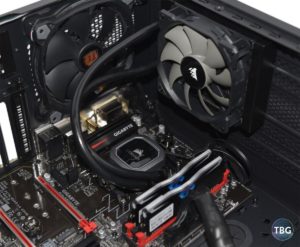 The installation process for the H60 was fairly straightforward, but a few things along the way made it more difficult than it needed to be. We’ve installed a lot of liquid coolers, many of them several times as we’ve rotated them through for testing, and the H60 fell somewhere in the middle in terms of time required for installation, at 25 minutes. Weighing in its favor is the fact that as a 120mm cooler, there’s simply less to handle: the radiator is half the size of 240mm models (and much lighter), there’s just one fan to install and connect, and it doesn’t take much effort finding a spot to place it in your case (any 120mm fan mount will do). Corsair also makes things simple by pre-applying the thermal paste comes.
The installation process for the H60 was fairly straightforward, but a few things along the way made it more difficult than it needed to be. We’ve installed a lot of liquid coolers, many of them several times as we’ve rotated them through for testing, and the H60 fell somewhere in the middle in terms of time required for installation, at 25 minutes. Weighing in its favor is the fact that as a 120mm cooler, there’s simply less to handle: the radiator is half the size of 240mm models (and much lighter), there’s just one fan to install and connect, and it doesn’t take much effort finding a spot to place it in your case (any 120mm fan mount will do). Corsair also makes things simple by pre-applying the thermal paste comes.
Unfortunately, there were also some issues that Corsair really could have avoided. First was that the the H60 uses clips that snap onto the cooling block and are nearly impossible to take off, and the Intel clips come pre-installed. So the first thing you have to do if installing the cooler on a Ryzen CPU is struggle to get those Intel clips off. Second was that the instruction manual was full of omissions and flat-out errors. The AMD clips that you need to install in place of the Intel clips have to be oriented in a specific direction, unlike the Intel clips, but the manual uses a top-down illustration that makes it impossible to tell which way the clips face. Then there’s the fact that the illustrations shows the use of eight washers to install the radiator and fan, when only four washers are included with the H60 and listed in the parts inventory. These should be used on the radiator, by the way, rather than the fan. Additionally, the AMD instructions refer to the use of four thumbscrews, when only two can be used (Intel uses four).
Finally, there’s the awful advice that Corsair continues to print in all of its cooler manuals that radiator fans be installed as intakes for best performance. This is simply bone-headed. First, as illustrated in the manual, the fan is mounted on the inside face of the radiator, which would put it in a “pull” orientation if used as in intake and massively limit airflow. We assume this is simply another error. But there’s a more fundamental concern: as any experienced builder knows, you do not, under any circumstances, blow hot air into your case. Yes, your CPU temps will drop, but you’ll cook the rest of your components, including your motherboard. Optimizing CPU temperatures at the expense of everything else is not good PC building practice.
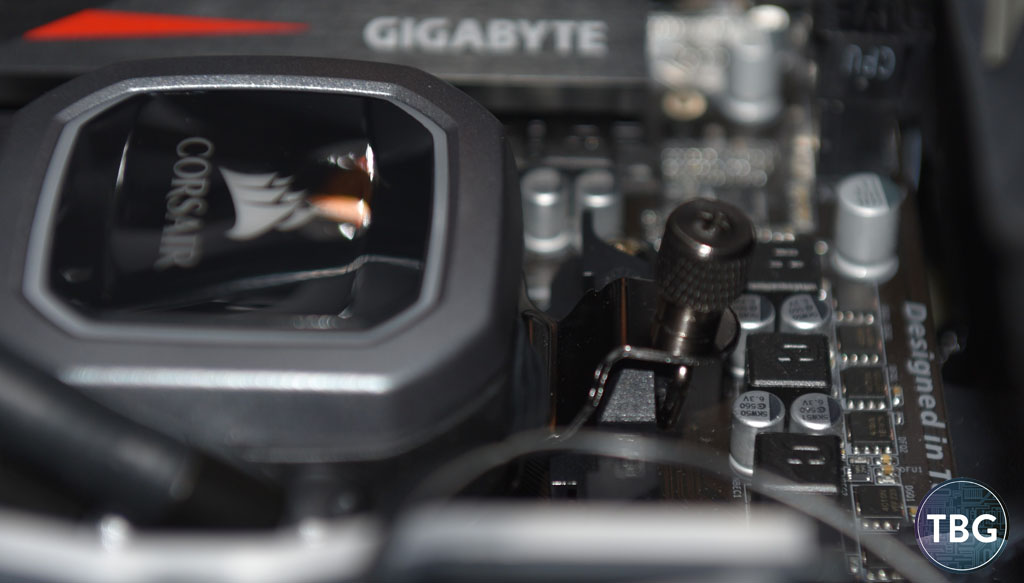
And there’s one more thing…. we were excited to see that the H60 has AM4 support, but then we were shocked to find that no AM4-specific brackets came in the box, as they do with every other cooler we’ve tested with built-in support for the AM4 socket. Well, it turns out that Corsair is simply using a “one-size-fits-all” AMD bracket, which happens to not fit AM4 very well, as shown above. The metal actually bends out of shape while affixing it, which makes us wonder what the long-term integrity of it will be, and also begs the question of whether it could be reused for a different AMD socket in the future (not that anyone would move from AM4 to an older socket, of course). Overall, this product feels a bit rushed, from the errors in the manual to the difficult to use clips to the mediocre bracket.
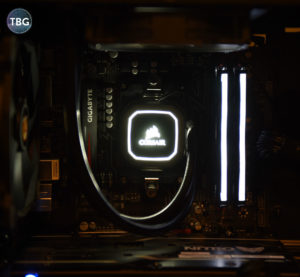 The cabling was also pretty simple, but again, it wasn’t ideal. Three connections have to be made: one fan cable for the pump, which functions only to provide tachometer data to the motherboard, a SATA power cable for the pump, and a 4-pin cable for the fan. We really wish that Corsair would do away with the need for SATA power, as have many of its competitors, as no one has SATA power connectors anywhere near their CPUs, so connecting this cable to a SATA daisy chain back behind the motherboard is a sure-fire recipe for cable spaghetti. We really have no idea why the fan connector attached to the pump isn’t used for both tach and power functions. Other manufacturers set it up that way, and while extensive RGB lighting could explain the need for more power, the H60 just has a simple white LED logo and surrounding white border.
The cabling was also pretty simple, but again, it wasn’t ideal. Three connections have to be made: one fan cable for the pump, which functions only to provide tachometer data to the motherboard, a SATA power cable for the pump, and a 4-pin cable for the fan. We really wish that Corsair would do away with the need for SATA power, as have many of its competitors, as no one has SATA power connectors anywhere near their CPUs, so connecting this cable to a SATA daisy chain back behind the motherboard is a sure-fire recipe for cable spaghetti. We really have no idea why the fan connector attached to the pump isn’t used for both tach and power functions. Other manufacturers set it up that way, and while extensive RGB lighting could explain the need for more power, the H60 just has a simple white LED logo and surrounding white border.
There’s another problem with this arrangement: with no control signals being passed from the pump assembly to or from the motherboard, the H60 pump is completely automatic, for better and for worse, and there is no user control of the lighting. It’s just full-on, all the time. At least it looks sweet, as shown in the accompanying photo!
To put it simply, Corsair cut corners to get this cooler to come in under $70. But if it works better than air coolers at $70, we’ll forgive Corsair for its transgressions. Let’s see how it does, shall we?
Stock Performance
At idle, all we really care about is noise. Sure, there’s some differentiation in terms of temperature, but a well-designed cooler will reduce noise to the minimum possible level while still operating at a safe temperature.
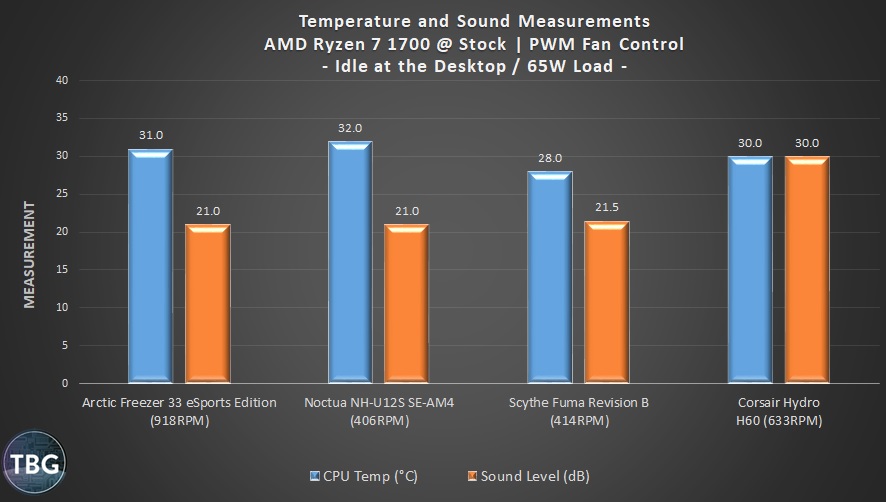
The H60 performed only so-so here. The CPU temperature sat at 30 °C, which is fine, but do to pump noise, the sound level hovered around 30dB. And this is indeed mostly pump noise, as the fan was running below 650RPM. Herein lies the pitfalls of using a fully automatic pump that doesn’t allow for any user control.
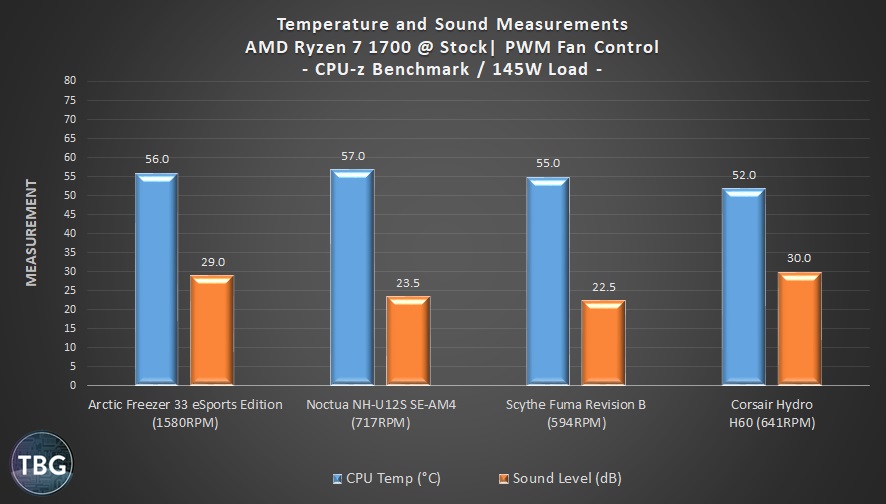
We were pretty impressed that sound levels didn’t move up much here, although it’s still louder than any of the air coolers. At least it wins easily on thermals, and we view this as a particularly important test: CPU-z’s built-in benchmark closely approximates the load created by intense gaming, and most users of the H60 likely aren’t going to be pushing huge overclocks, so this stock test is quite relevant. We like what we see here.
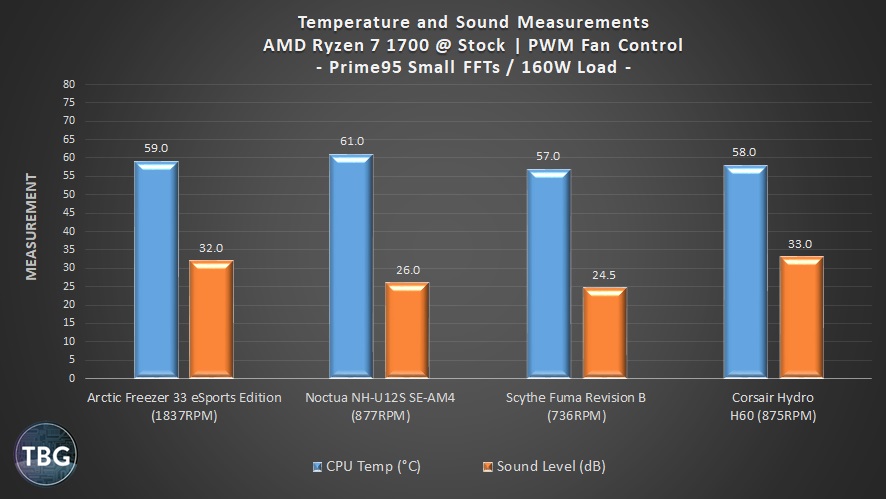
When we really push our stock-clocked Ryzen 7 1700 using Prime95 Small FFTs, things get a bit more challenging. The Hydro H60 is still the loudest in the test, and it’s beaten in terms of thermals by the ~$45 Scythe Fuma Rev. B, which happens to be a pain to install, but also the best air cooler we’ve ever tested. They Hydro H60 puts up a fight, though, arguably looks better, and surely fits in more cases.
Overclocked Performance
All right, moving onto overclocked performance, let’s see if the little Hydro H60 can hang on with the big boys. We’ve brought in data for three more coolers here, the Noctua NH-D15 (the best 140mm tower on the market), the CoolerMaster MasterLiquid 240, which practically matches the Hydro H60 in price despite being twice as large, and the big 280mm Thermaltake Water 3.0. Note that we’re going to skip idle metrics here, because no one overclocks a PC to watch it sit idle all day!
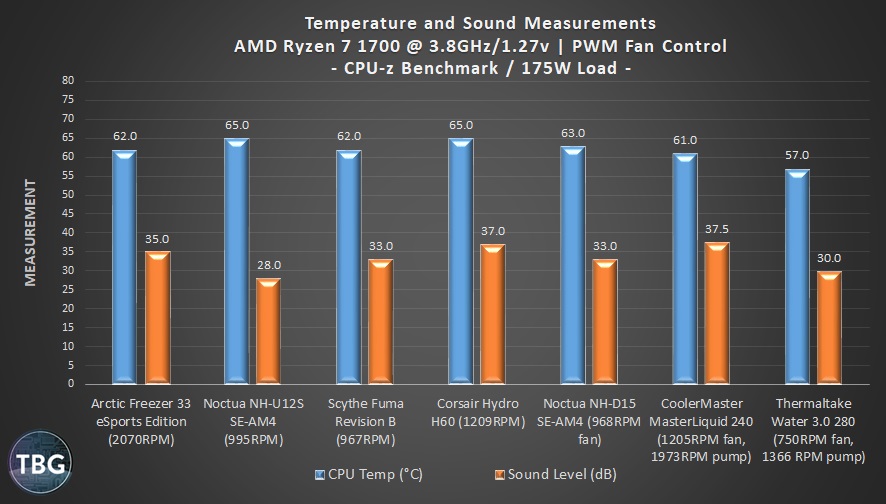
In CPU-z, which is the best test of real-world loads, we see the Hydro H60 doing OK, matching the similarly-priced Noctua NH-U12S 120mm air cooler in terms of temperature, but certainly not scoring that high in the performance-to-noise contest.
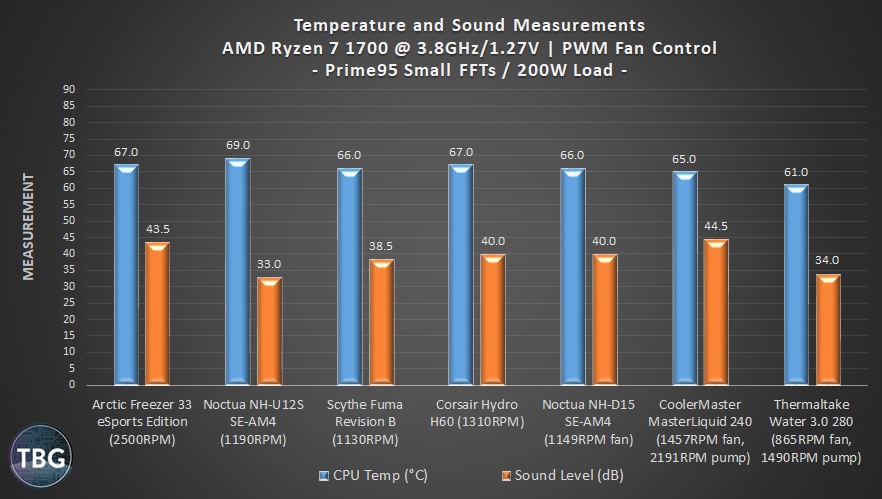
In our most challenging test, we actually see the H60 do all right. It’s handling the heat as well as the air coolers in our test, while staying pretty competitive in terms of noise. At this point, its pump noise isn’t a handicap, as fan noise dominates, and the other liquid coolers have to turn up their pump RPMs too. You can see that the Hydro H60 nearly matches the bigger MasterLiquid 240, yet comes in much quieter. It even does well against the mighty Noctua NH-D15 140mm air cooler.
Conclusion
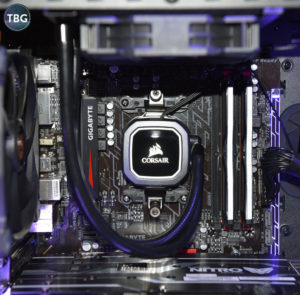 Overall, we like what Corsair has done with the new-for-2018 H60. While it borrows a venerable name, it is clearly a brand-new product. It looks better than the previous version of the H60, offers a much more sophisticated look than any air cooler, and it comes in at a fair price. It’s the ideal first step into liquid cooling for novice builders, given that it’s reasonably quiet at load and offers great compatibility with compact cases.
Overall, we like what Corsair has done with the new-for-2018 H60. While it borrows a venerable name, it is clearly a brand-new product. It looks better than the previous version of the H60, offers a much more sophisticated look than any air cooler, and it comes in at a fair price. It’s the ideal first step into liquid cooling for novice builders, given that it’s reasonably quiet at load and offers great compatibility with compact cases.
The only concerns we have are with regard to idle noise and ease of installation. Due to a constant pump speed, noise at idle is unnecessarily high. Most higher-end liquid coolers we’ve tested automatically adjust pump speed downwards for low temperatures, or at least give users the option to manually do so. And the installation process, while fairly simple, is made more difficult by a manual that has several errors in the instructions for the AMD AM4 socket. We also have to wonder if using the same bracket for both AM3 and AM4 was a wise decision on Corsair’s part.
All that being said, the Corsair Hydro H60 (2018) is a great new addition to the liquid cooler market. Yes, it has an old name, but it’s a brand new product, and it’s a fantastic option at its pricepont. It’s available for $69.99 shipped from Amazon, as of our publication date.

